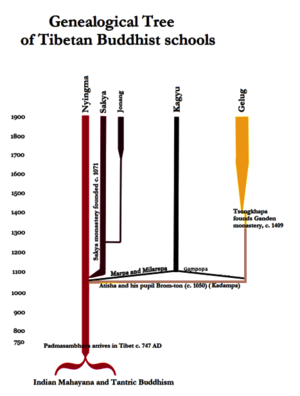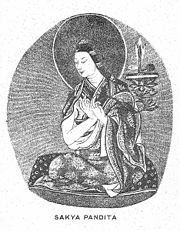Schools of Tibetan Buddhism
In Tibet, distinct schools of Tibetan Buddhism arose due to differences in the time of translation of texts from India and the development of lineages formed by particular teachers.[1]
Today, four schools are widely known: Nyingma, Sakya, Kagyu, and Gelugpa.[2]
The smaller Jonang school, which branched off from the Sakya school, is sometimes identified as a separate school.
The Bon tradition is also sometimes grouped with the above four or five schools.
Four main schools
According to Alexander Berzin, the four main schools overlap markedly, such that "about eighty percent or more of the features of the Tibetan schools are the same".[3] Differences include the use of different terminology to indicate equivalent concepts, opening dedications of texts to different deities and whether phenomena are described from the viewpoint of an unenlightened practitioner or of a Buddha.[3]
The 14th Dalai Lama also emphasizes that the four main schools have no fundamental differences on questions of philosophy.[4]
Nyingma

The Nyingma school traces its origin back to the great Indian adept Padmasambhava and the translator Śāntarakṣita. The Nyingma school emphasizes the practice of Dzogchen. Terma "treasures" (revealed texts) are of particular significance to the Nyingma school.
Kagyupa
There are two main branches of the Kaygu school, both of which trace their origins back through the Indian tantric practioner Tilopa and his student Naropa. The Dagpo Kagyu lineage trace themselves back to Niropa's student Marpa Lotsawa, a great Tibetan translator who traveled to India to recieve teachings from Niropa. Marpa passed his teachings onto his greatest student Milarepa, a famouse 11th-century mystic. Milerapa's student Gampopa is recognized that the founder of Dagpo Kagyu.[5]
The Shangpa Kagyu trace there lineage back to Naropa, as well as two female trantric practitioners – Niguma and Sukhasiddhi. The late Kalu Rinpoche came from this tradition.[5]
Sakya
The Sakya tradition was the second to arise from the new transmission period at the end of the 10th century. The Sakya lineage derives from the Indian yogi Virupa and some other translators.
- Their main teaching from Virupa is known as “lamdre” – lam is path and dre is result. This “path and its results” system is a combination of lam-rim type material conjoined with the tantric practice of Hevajra.[5]
This leader of this tradition is called the Sakya Trizin. The Sakya Pandita (1182–1251CE) was one of its most famous exponents.
Gelug
The Gelug school was originally a reformist movement and is known for its emphasis on logic and debate. The order was founded in the 14th to 15th century by Je Tsongkhapa, renowned for both his scholarship and virtue. Its spiritual head is the Ganden Tripa and its temporal one the Dalai Lama. The Dalai Lama is regarded as the embodiment of Avalokiteśvara. Successive Dalai Lamas ruled Tibet from the mid-17th to mid-20th centuries.
Classifications of Nyingma and Sarma
These four major schools are sometimes categorized as belonging to an earlier and later tranmissions. In this context, the categories are:
- the Nyingma ("old ones") representing the first major period of translation
- the Sarma ("new ones") representing the later period of translation and tantric lineages. The Sarma consists of the other three schools: Sakya, Kagyu and Gelug.
Other notable schools
Jonang
The Jonang is a minor school that branched off from the Sakya tradition. It was suppressed in 1650 in Gelug-controlled regions and subsequently banned; many of its monks and nuns converted to the Gelug school in 1658.
The Jonang re-established their center of activiy in the Golok, Nakhi and Mongol areas of Kham and Amdo--centered at Dzamthang Monastery. An estimated 5,000 monks and nuns of the Jonang tradition practice today in these areas and at the edges of historic Gelug influence.
Their teachings were limited to these regions until the Rimé movement of the 19th century encouraged the study of non-Gelug schools of thought and practice.[6] In modern times, the Jonang schools has been encouraged to grow by the 14th Dalai Lama, who installed the 9th Jebtsundamba Khutughtu as its head.
Kadampa
The Kadampa (T. bka' gdams pa) tradition was founded in the 11th century by the great Bengali master Atiśa (982-1054) and his students such as Dromtön (1005–1064). The Kadampa stressed compassion, pure discipline and study.[7]
The most evident teachings of that tradition were the graduated teachings on the Mahayana path. These special presentations became known as lojong (mind training) and lamrim (stages of the path). Kadam masters like Atiśa also promoted the study of madhyamaka philosophy.
With the rise of new Tibetan Buddhist schools like Sakya and Gelug, Kadam ceased to exist as an independent school, and its monasteries, lineages and traditions were absorbed into all major schools of Tibetan Buddhism.[8] Because of this, Kadampa lineages remained strong long after the school disappeared.[7]
References
- ↑ Powers 2007, p. 355.
- ↑ Traditional texts identify eight schools, but some of these traditional schools are no longer practiced.
- ↑ 3.0 3.1
 The Tibetan Buddhist and Bon Traditions: A Comparison, StudyBuddhism
The Tibetan Buddhist and Bon Traditions: A Comparison, StudyBuddhism
- ↑
 The four main schools of Tibetan Buddhism, Rigpa Shedra Wiki
The four main schools of Tibetan Buddhism, Rigpa Shedra Wiki
- ↑ 5.0 5.1 5.2
 How Did Tibetan Buddhism Develop?, StudyBuddhism
How Did Tibetan Buddhism Develop?, StudyBuddhism
- ↑ Gruschke 2001, p.72; and A. Gruschke, "Der Jonang-Orden: Gründe für seinen Niedergang, Voraussetzungen für das Überdauern und aktuelle Lage", in: Henk Blezer (ed.), Tibet, Past and Present. Tibetan Studies I (Proceedings of the Ninth Seminar of The IATS, 2000), Brill Academic Publishers, Leiden 2002, pp. 183-214
- ↑ 7.0 7.1 Chokyi Dragpa (2015). Illuminating the Thirty-Seven Practices of a Bodhisattva, Glossary. Simon and Schuster.
- ↑ Van Schaik, Sam (2016). The Spirit of Tibetan Buddhism, p. 33. Yale University Press.
Sources
- Powers, John (2007), Introduction to Tibetan Buddhism (PDF) (2nd ed.), Ithaca, N.Y.: Snow Lion Publications, ISBN 1-55939-835-3
Videos
Search for videos:
- Search YouTube for: Schools of Tibetan Buddhism Buddhism
Selected videos:
- The Differences between the Four Tibetan Schools
- Description: Mingyur Rinpoche talks about the 4 main schools of Tibetan Buddhism: Nyingma, Kagyu, Sakya and Gelug. He explains that the meaning of the teachings is the same in all four schools, but they have differences in emphasis. The main emphasis of Nyingmapa is practice, with the most important part of practice being the view. The main emphasis in Kagyupa is the practice of meditation, and the focus is to see your true nature. In the Sakyapa the main emphasis is on the development and completion stages of practice. And the main emphasis of the Gelupa school is study and discipline, and then to practice
External links
 How Do the Tibetan Buddhist Traditions Differ?, StudyBuddhism
How Do the Tibetan Buddhist Traditions Differ?, StudyBuddhism The Tibetan Buddhist and Bon Traditions: A Comparison, StudyBuddhism
The Tibetan Buddhist and Bon Traditions: A Comparison, StudyBuddhism How Did Tibetan Buddhism Develop?, StudyBuddhism
How Did Tibetan Buddhism Develop?, StudyBuddhism The four main schools of Tibetan Buddhism, Rigpa Shedra Wiki
The four main schools of Tibetan Buddhism, Rigpa Shedra Wiki The Four Dharma Traditions of the Land of Tibet, Lotsawa House
The Four Dharma Traditions of the Land of Tibet, Lotsawa House Satirical Advice for the Four Schools, Lotsawa House
Satirical Advice for the Four Schools, Lotsawa House- Buddhism in Tibet (official Kagyu website)
- The Four Lineages of Tibetan Buddhism (Mingyur Rinpoche)

